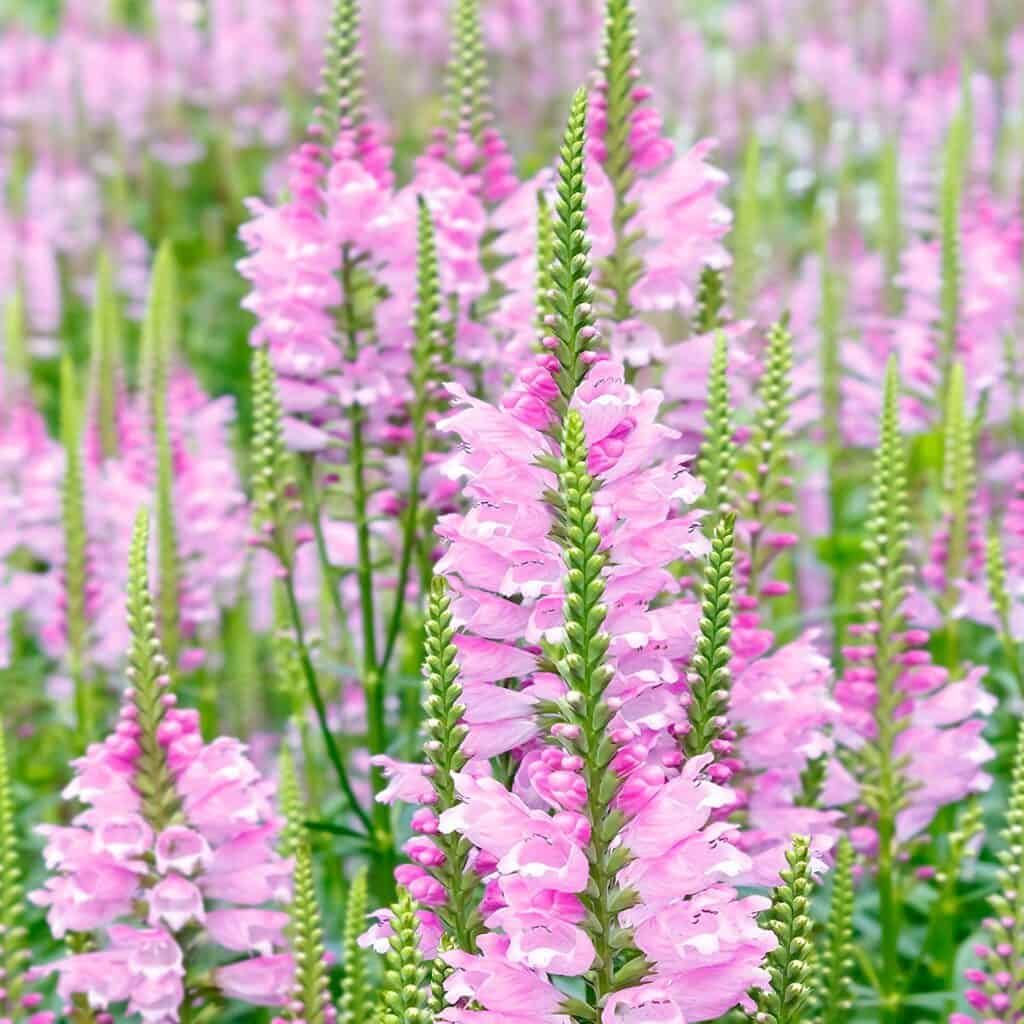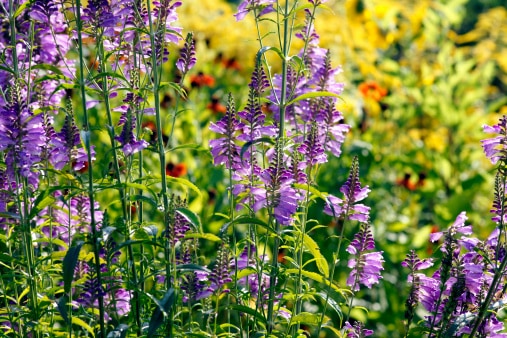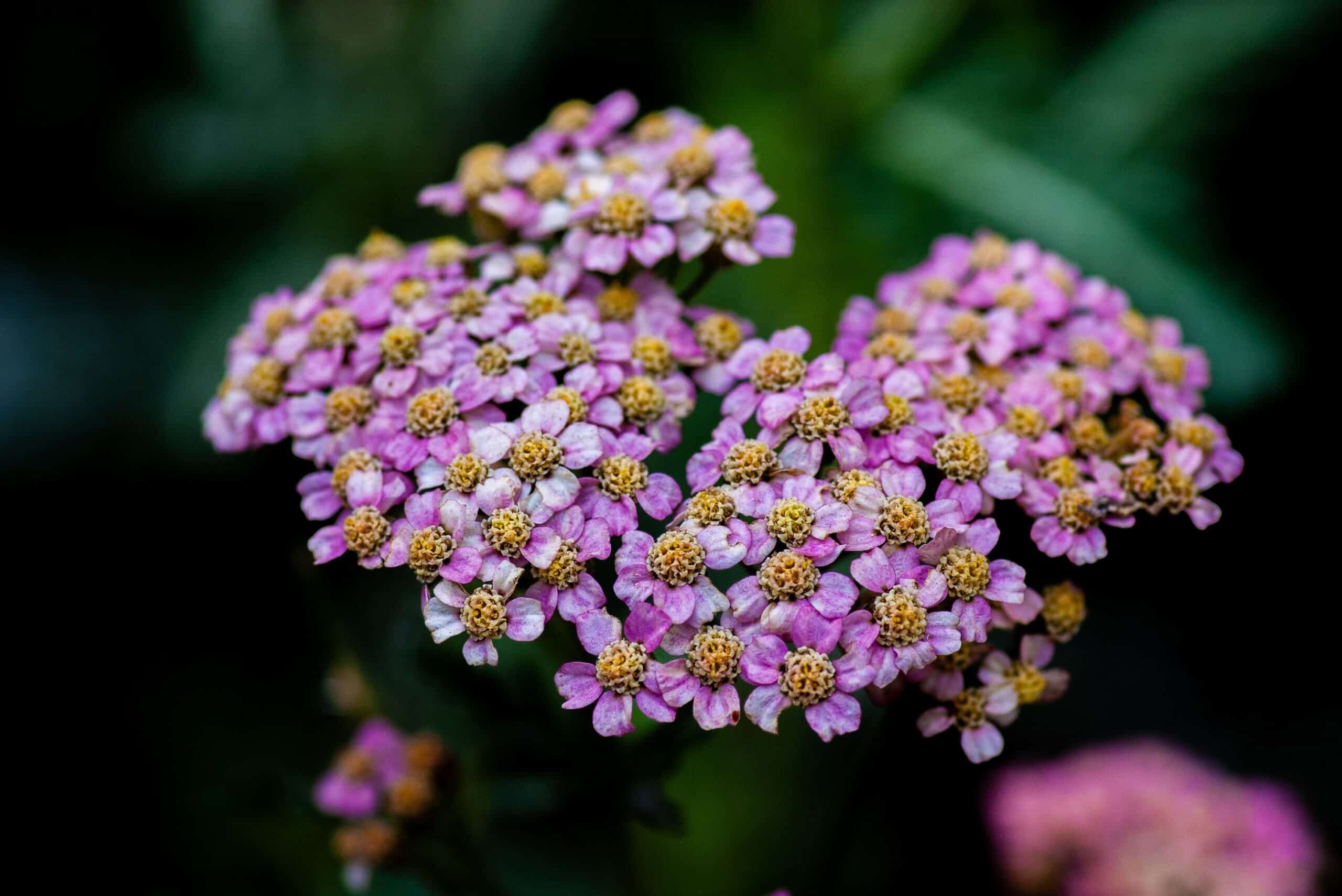The Obedient Plant, or Physostegia virginianais, is a species of flowering perennial herbaceous plant that belongs to the Plantaginaceae family. It is an erect plant, frequently grown as ornamental foliage because of its full spikes of lilac to pink tubular flowers. Its common name comes from its characteristic of being able to be bent in any direction and staying in position. This herbaceous perennial grows best in hardiness zones 3–9 in a location with full to partial sun.
 Buy Obedient Plant Seeds on Amazon>>
Buy Obedient Plant Seeds on Amazon>>
Soil
This species of foliage prefers soil that is slightly acidic to slightly alkaline and of medium fertility. As far as watering, the Obedient Plant does best in soils that are moist, but not perpetually damp or dry. Throughout the year, average temperatures in the range of 65–80°F (18–27°C) are suitable, while temperatures below 20°F (-6°C) and above 95°F (35°C) can be damaging or fatal.
Fertilization
In terms of fertilization, light fertilization during the growing season is recommended. Use a low-nitrogen fertilizer that is rich in phosphorous and potassium, such as one that is specifically marketed for flowering plants. The blooming period for Physostegia virginiana is mid-summer through mid-fall, and its flowers attract hummingbirds as well as bees.
Buy Flowers on FloristOne>>
Planting
When planting the Obedient Plant indoors, choose a potting container that is approximately 15 cm deep and wide. Ensure that the pot has provisions for proper drainage, such as drain holes. When transplanting the plant, use a standard potting soil mix and water the soil adequately afterwards. When the plant is outdoors, maintain a pH level between 6.0 to 8.0 and avoid extremes in either acid or alkaline soils.
Pruning
Pruning is necessary to shape the Physostegia virginiana as it grows and to remove damaged or infested foliage. After deadheading the flower spikes and pruning excess stems and roots, one can propagate the plant through cuttings or division. The cuttings should be taken in the early spring, during when the the plant has resumed active growth.
How to Propagate
Propagation can also be achieved by division in the early spring. Simply dig up a mature clump and cut it into several sections, each containing at least three stems as well as a healthy portion of roots. After planting the divisions to their desired locations, water adequately.
Pests and Plant diseases
Several pests and plant diseases can affect your Obedient Plant. Aphids, caterpillars, thrips, and whiteflies are some of the more common pests, so regular inspections for infestation are necessary. To control these pests, apply insecticides or integrate natural pest management control strategies. Among the more common plant diseases are Fusarium and Alternaria root rot, powdery mildew, rust and downy mildew, and Verticillium wilt. To prevent diseases, steps should be taken to reduce moisture and humidity around the plant and remove leaf litter and other debris.
3 FAQs about Physostegia Virginiana
Q. In what type of soil does Physostegia virginiana grow best?
A. Physostegia virginiana grows best in soils with medium fertility and slightly acidic to slightly alkaline pH.
Q. How cold can Physostegia virginiana tolerate?
A. Physostegia virginiana can tolerate temperatures as low as 20°F (-6°C). However, temperatures below this or above 95°F (35°C) can be damaging or even fatal.
Q. At what time of the year should Physostegia virginiana be cut back?
A. Physostegia virginiana should be cut back in the early spring in order to shape the plant as it grows and to remove damaged or infested foliage.
Fact Sheet
| Name | Obedient Plant and Physostegia virginiana |
|---|---|
| Family | Plantaginaceae |
| Plant Type | Perennial |
| Mature Size | 6 – 24 inches in height |
| Sun Exposure | Full sun to partial shade |
| Soil Type | Rich, well-drained soil |
| Soil pH | 6.0 – 8.0 |
| Bloom Time | Mid-summer to mid-fall |
| Flower Color | Lilac to pink |
| Hardiness Zones | 3 – 9 |
| Native Area | North America |
The Obedient Plant, or Physostegia virginiana, is one of many different types of flowering plants. Originally native to North America, this plant is now grown as both an indoor and outdoor ornamental. With its uniquely patterned spikes of lilac to pink tubular flowers and its tendency to stay in whatever direction it is bent, this species of foliage makes a beautiful addition to any garden.
Whether grown outdoors or indoors in a pot, the Obedient Plant is an undemanding and hardy specimen. It thrives in hardiness zones 3 – 9, preferring soils that are slightly acidic to slightly alkaline and of medium fertility. It prefers a location with full to partial sun and adequate water, but not a constant dampness. Suitable temperatures range from 65°F to 80°F (18–27°C). Light fertilization during the growing period with a low-nitrogen fertilizer, such as one specially formulated for flowering plants, helps the plant bloom successfully.
Regular maintenance is important to keep the Physostegia virginiana looking its best. Pruning should be done to shape the plant as well as to remove any damaged or infested foliage. Propagation can done through either cutting or division, in the early spring. When planting indoors, ensure the pot is 15 cm deep and wide, and that it has proper drainage provisions.
Common pests, such as aphids, caterpillars, thrips, and whiteflies can be controlled through either insecticides or through natural pest management strategies. Common plant diseases, such as Fusarium, Alternaria root rot, powdery mildew, rust, downy mildew, and Verticillium wilt can be minimized through reducing the moisture around the plant and by removing leaf litter and other debris in the area.
The Obedient Plant is a resilient and beautiful plant that is sure to not only brighten up any garden or living room but will also do its part in attracting hummingbirds and bees. It’s no wonder it is such a popular choice!
What we love from Amazon this week
Buy these wonderful flowers directly from Amazon:
















